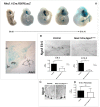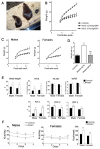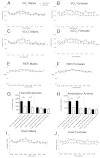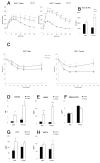Conditional deletion of neurogenin-3 using Nkx2.1iCre results in a mouse model for the central control of feeding, activity and obesity
- PMID: 23649822
- PMCID: PMC3759333
- DOI: 10.1242/dmm.011916
Conditional deletion of neurogenin-3 using Nkx2.1iCre results in a mouse model for the central control of feeding, activity and obesity
Abstract
The ventral hypothalamus acts to integrate visceral and systemic information to control energy balance. The basic helix-loop-helix transcription factor neurogenin-3 (Ngn3) is required for pancreatic β-cell development and has been implicated in neuronal development in the hypothalamus. Here, we demonstrate that early embryonic hypothalamic inactivation of Ngn3 (also known as Neurog3) in mice results in rapid post-weaning obesity that is associated with hyperphagia and reduced energy expenditure. This obesity is caused by loss of expression of Pomc in Pomc- and Cart-expressing (Pomc/Cart) neurons in the arcuate nucleus, indicating an incomplete specification of anorexigenic first order neurons. Furthermore, following the onset of obesity, both the arcuate and ventromedial hypothalamic nuclei become insensitive to peripheral leptin treatment. This conditional mouse mutant therefore represents a novel model system for obesity that is associated with hyperphagia and underactivity, and sheds new light upon the roles of Ngn3 in the specification of hypothalamic neurons controlling energy balance.
Figures







Similar articles
-
Differential requirements for neurogenin 3 in the development of POMC and NPY neurons in the hypothalamus.Dev Biol. 2011 Jan 15;349(2):406-16. doi: 10.1016/j.ydbio.2010.11.007. Epub 2010 Nov 11. Dev Biol. 2011. PMID: 21074524
-
The Homeodomain Transcription Factor NKX2.1 Is Essential for the Early Specification of Melanocortin Neuron Identity and Activates Pomc Expression in the Developing Hypothalamus.J Neurosci. 2019 May 22;39(21):4023-4035. doi: 10.1523/JNEUROSCI.2924-18.2019. Epub 2019 Mar 18. J Neurosci. 2019. PMID: 30886014 Free PMC article.
-
The homeodomain transcription factor Six3 regulates hypothalamic Pomc expression and its absence from POMC neurons induces hyperphagia and mild obesity in male mice.Mol Metab. 2024 Sep;87:101993. doi: 10.1016/j.molmet.2024.101993. Epub 2024 Jul 16. Mol Metab. 2024. PMID: 39025297 Free PMC article.
-
AgRP/NPY and POMC neurons in the arcuate nucleus and their potential role in treatment of obesity.Eur J Pharmacol. 2022 Jan 15;915:174611. doi: 10.1016/j.ejphar.2021.174611. Epub 2021 Nov 17. Eur J Pharmacol. 2022. PMID: 34798121 Review.
-
Pro-opiomelanocortin Neurons and the Transcriptional Regulation of Motivated Exercise.Exerc Sport Sci Rev. 2020 Apr;48(2):74-82. doi: 10.1249/JES.0000000000000219. Exerc Sport Sci Rev. 2020. PMID: 32168170 Review.
Cited by
-
Rare Variants in Genes Linked to Appetite Control and Hypothalamic Development in Early-Onset Severe Obesity.Front Endocrinol (Lausanne). 2020 Feb 21;11:81. doi: 10.3389/fendo.2020.00081. eCollection 2020. Front Endocrinol (Lausanne). 2020. PMID: 32153512 Free PMC article.
-
Neurog2 Acts as a Classical Proneural Gene in the Ventromedial Hypothalamus and Is Required for the Early Phase of Neurogenesis.J Neurosci. 2020 Apr 29;40(18):3549-3563. doi: 10.1523/JNEUROSCI.2610-19.2020. Epub 2020 Apr 9. J Neurosci. 2020. PMID: 32273485 Free PMC article.
-
Neurogenin3 phosphorylation controls reprogramming efficiency of pancreatic ductal organoids into endocrine cells.Sci Rep. 2018 Oct 18;8(1):15374. doi: 10.1038/s41598-018-33838-5. Sci Rep. 2018. PMID: 30337647 Free PMC article.
-
POMC Neurons: From Birth to Death.Annu Rev Physiol. 2017 Feb 10;79:209-236. doi: 10.1146/annurev-physiol-022516-034110. Annu Rev Physiol. 2017. PMID: 28192062 Free PMC article. Review.
-
Development of the hypothalamus: conservation, modification and innovation.Development. 2017 May 1;144(9):1588-1599. doi: 10.1242/dev.139055. Development. 2017. PMID: 28465334 Free PMC article. Review.
References
-
- Chen H., Simar D., Lambert K., Mercier J., Morris M. J. (2008). Maternal and postnatal overnutrition differentially impact appetite regulators and fuel metabolism. Endocrinology 149, 5348–5356 - PubMed
-
- Cowley M. A., Smart J. L., Rubinstein M., Cerdán M. G., Diano S., Horvath T. L., Cone R. D., Low M. J. (2001). Leptin activates anorexigenic POMC neurons through a neural network in the arcuate nucleus. Nature 411, 480–484 - PubMed
Publication types
MeSH terms
Substances
Grants and funding
LinkOut - more resources
Full Text Sources
Other Literature Sources
Medical
Molecular Biology Databases
Miscellaneous

